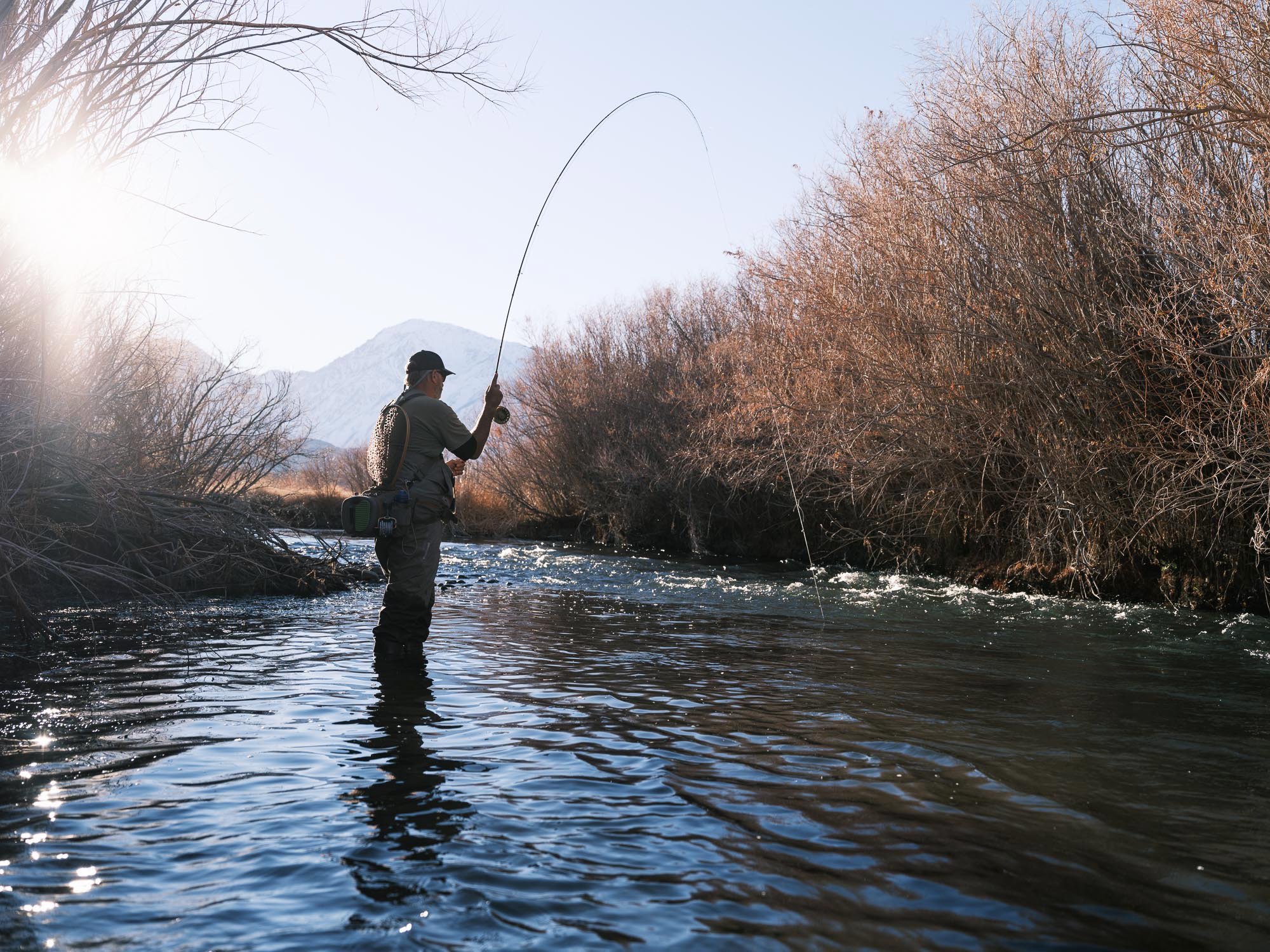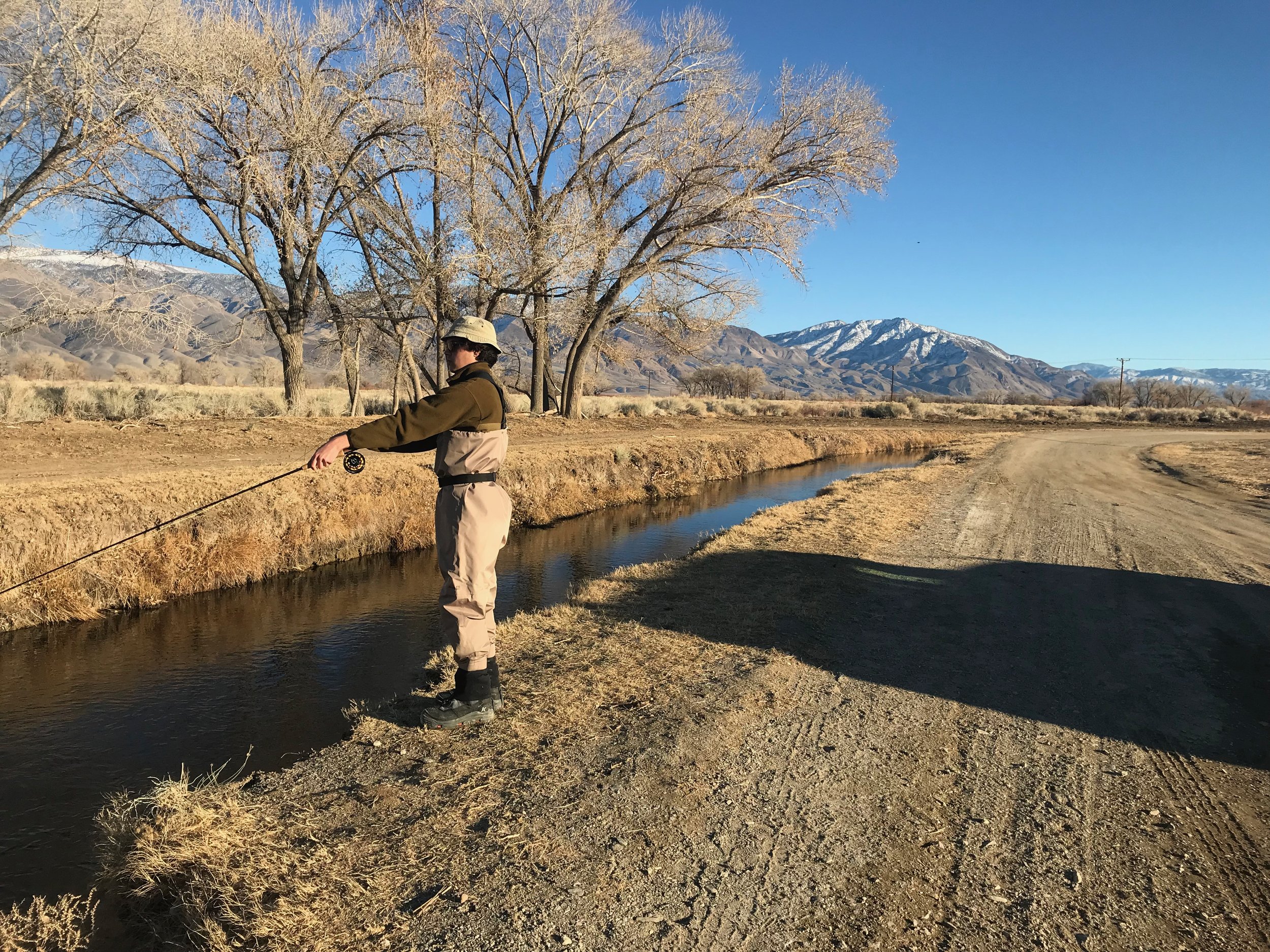Weather impacts the winter fly fishing in the Eastern Sierra. We are in for a week of sunny days with no big weather fronts anticipated. The increased day light is helping to warm up the streams so the insects and trout are more active middle of the day from 10:00 A.M. to 2:00 P.M. We are in the middle of winter and it is midge time. This is the trout’s stable food source when other aquatic insects are inactive. Midges in size 16 to 20 cover the range of midges found in the streams and rivers of the Eastern Sierra.
Fly fishers are hooking up middle of the day when the trout and insects are most active. Photo by Embry Rucker
Lower Owens River:
Wild Trout Section:
The wild trout section of the lower Owens River is offering consistent mid-day fly fishing with nymphs for wild brown trout. Fly fishers can expect to hook up using mayfly nymphs and midges. Euro nymphing and fishing under an indicator is the most productive way to fly fish the lower Owens River. There are a few fish rising in the middle of the day to emerging midges if you are in the right spot. Pheasant tail nymphs, peeking caddis, tiger midges, zebra midges, and blood midges are fooling the brown trout. Key to success is having the right amount of weight on the rig to get a drag free drift of the nymphs on the substrate.
Embry Rucker from Encinitas working a size 18 bead head flash back pheasant tail nymph under an indicator on one of the riffles in the catch and release section of the lower Owens River.
Hot Creek:
Interpretive Site:
Fly fishers have been accessing the interpretive site by walking in from Hot Creek Hatchery Road. Enough fly fishers, along with warmer weather, have packed down the snow to make for easier access into Hot Creek. Fishing has been slow with nymphing under an indicator or under a dry fly producing a few wild brown trout. Conditions remind me of the dogs days of summer. What we have now are the frozen days of winter. Fly fishers willing to work hard are landing a few wild brown and rainbow trout in the middle of the day.
Hot Creek:
Canyon Section:
To fly fish the canyon section of Hot Creek fly fishers have to put in extra effort to access the three parking lots. Walking, snowshoeing, or cross country skiing in from Hot Creek Hatchery Road where they stop plowing is required to get to the canyon. Fly fishing has been tough as there is not much insect activity going on for the trout to feed on. The primary insect in the canyon has been midges. Black and red bodied midges are your best patterns right now. I fish with tiger midges, zebra midges, blood midges, two tone brassies, and Manhattan midges in sizes 16 to 20.
Fly fishers trekking into the upper Owens River need to be prepared for the days conditions. Photo by Embry Rucker
Upper Owens River:
Above Benton Crossing Bridge:
Mornings have been cold with temperatures in the negative range. Fly fishers heading a mile or two upstream from Benton Crossing Bridge need to be prepared for adverse conditions. The trophy trout are on the bite and can be found feeding in the deeper holes and runs. Stoner nymphs, green/gold wire Prince nymphs, gold ribbed hare’s ears, and copper John’s are the fly patterns that I have the best luck with. These flies need to be fished down deep in the pools and runs. Don’t be afraid to add additional weight to get the flies down on the substrate where the trophy trout are feeding.
Bishop Creek Canal Behind the Ford Dealer:
This area continues to be under-utilized by fly fishers and offers good mid-day fly fishing nymphing under an indicator, using the dry and dropper method, or Euro nymphing. The wild brown trout are taking midge nymphs, midge pupae, and mayfly nymphs. For the dry fly in the dry and dropper rig I’m using a size 16 Adams parachute. For the nymphs under an indicator or the dry fly I’m fishing with size 18 bead head flash back pheasant tail nymphs, size 20 tiger midges, zebra midges, blood midges, two tone brassies, and Manhattan midges. On the Euro rig I’m fishing with a size 16 or 18 olive quilldigon, size 18 tiger midge, size 12 stoner nymph, size 16 Butano nymph, size 16 thread Frenchie, and a size 16 hot spot pheasant tail nymph.
Peter Moglia from Hermosa Beach nymphing Bishop Creek Canal on a sunny day in the Owens Valley.




